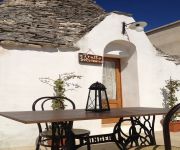Facts and Data
Webpages:
Official Unesco Page
Comune di Alberobello (only in Italian)
Basis Data:
Unesco World heritage since: 1996
Size of heritage: 11 ha
Coordinates:
Longitude: 17,237°
Latitude: 40,783°
Summary
The trulli , limestone dwellings found in the southern region of Puglia, are remarkable examples of drywall (mortarless) construction, a prehistoric building technique still in use in this region. The trulli are made of roughly worked limestone boulders collected from neighbouring fields. Characteristically, they feature pyramidal, domed or conical roofs built up of corbelled limestone slabs.
Location on Map
Show bigger map on Openstreetmap
The Trulli of Alberobello: A Unique UNESCO World Heritage Site
The Trulli of Alberobello, located in the Province of Bari in the Puglia region of Italy, is a remarkable UNESCO World Heritage site that showcases a unique architectural style. These traditional dry stone huts, known as trulli, have become an iconic symbol of the region and attract visitors from around the world.
History
The history of the Trulli of Alberobello dates back to the 14th century when the area was under the rule of the Kingdom of Naples. The trulli were originally built as temporary shelters for agricultural workers and farmers. The dry stone construction technique, without the use of mortar, allowed the locals to dismantle the structures quickly to avoid paying taxes on permanent dwellings.
Over time, the trulli evolved into permanent homes as the population grew. The unique design of these structures, with their conical roofs and whitewashed walls, became a symbol of the region's identity and cultural heritage.
Architecture
The trulli are constructed using local limestone, carefully stacked without the use of mortar. The conical roofs, made of overlapping stone slabs, are a distinctive feature of these structures. The roofs often feature decorative pinnacles, known as pinnacoli, which are believed to have symbolic and religious significance.
Inside the trulli, visitors can admire the traditional layout of the rooms. The central living area, known as the "alcove," is often adorned with religious icons and serves as a gathering space for the family. The trulli also feature small windows and narrow doorways, designed to keep the interiors cool during the hot summers and warm during the cold winters.
Current State
Today, the Trulli of Alberobello is a well-preserved UNESCO World Heritage site and a major tourist attraction. The town of Alberobello itself is divided into two areas: Rione Monti and Aia Piccola, both of which are filled with trulli.
Rione Monti, the larger of the two areas, is home to approximately 1,000 trulli. Here, visitors can wander through narrow streets lined with these unique structures, which now house shops, restaurants, and even accommodations. The trulli have been adapted to modern needs while preserving their original charm.
Aia Piccola, the smaller area, is a residential neighborhood where locals still live in trulli. This part of Alberobello offers a glimpse into the daily lives of the residents and provides a more authentic experience for visitors.
The Trulli of Alberobello have not only become a symbol of the region but also a source of pride for the local community. The preservation and maintenance of these unique structures are carefully regulated to ensure their cultural significance is protected for future generations.
Visiting the Trulli of Alberobello is like stepping back in time, immersing oneself in the rich history and architectural beauty of this UNESCO World Heritage site. It is a testament to the ingenuity and creativity of the people who built these remarkable structures, leaving a lasting legacy for all to admire.
Hotels and places to stay
Trulli e Puglia
Le Alcove Luxury Resort nei Trulli
Hotel Astoria
Colle Del Sole Hotel
Victor Country
Airone
Hotel Ramapendula
Trullidea
Trulli Holiday
Trulli Colarossa
Videos from the area
Videos provided by Youtube are under the copyright of their owners.

















